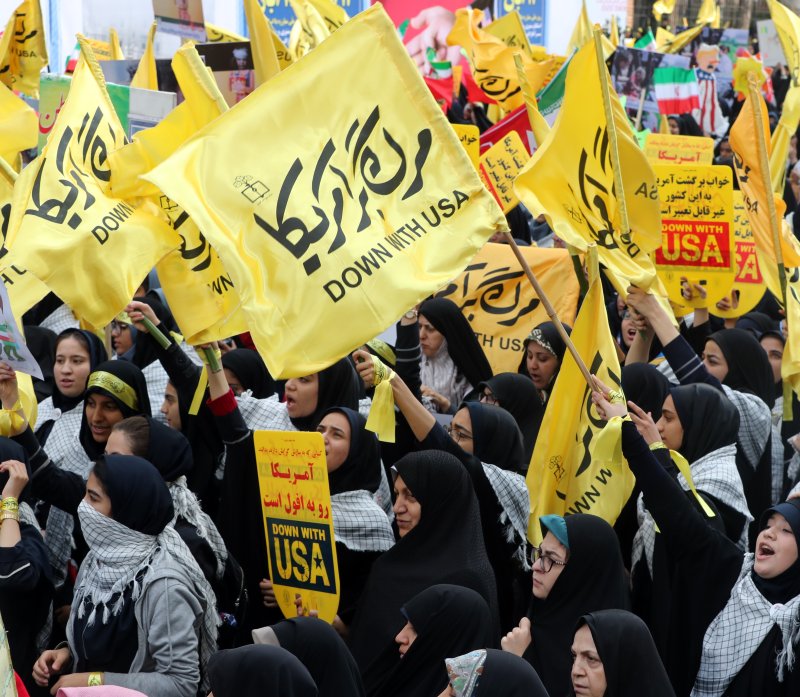1 of 4 | Iranians take part in an anti-U.S. demonstration marking the 40th anniversary of U.S. Embassy takeover in front of the former U.S. Embassy in Tehran on Monday. Photo by Abedin Taherkenareh/EPA-EFE
Nov. 4 (UPI) -- Rallies and events were staged across Iran Monday to celebrate the 40th anniversary of the start of what would last for 444 days and be known as the Iran hostage crisis.
Amid new tensions between Tehran and the United States, demonstrations nationwide marked the Iran's National Day of Protest against Global Arrogance. The demonstrators chanted slogans against the United States and Israel and set their flags on fire.
In Tehran, students and activists gathered outside the former U.S. Embassy, where on Nov. 4, 1979, a group of students stormed the building and took dozens of U.S. State Department workers hostage. The move was a show of defiance against U.S.-backed Shah Mohammad Reza Pahlavi.
The student protesters loyal to Ayatollah Ruhollah Khomeini stormed the embassy to demand the United States return Pahlavi -- who Washington had taken in -- to Iran for trial and possible execution.
"Marine guards fought back with tear gas but they were ordered not to open fire because the attackers were unarmed and within a couple of hours all the Americans within the compound and a number of staff and visitors from other nations had been taken captive," UPI reporter Edmond Smith said at the time.
The loyalists took hold of the U.S. Embassy and kept a total of 66 hostages captive, including diplomats, staff members and a handful of civilians. Then-President Jimmy Carter tried for more than a year, unsuccessfully, to negotiate the hostages' release.
Small groups of hostages were released incrementally about two weeks later, but 52 remained captive for 444 days -- until the day President Ronald Reagan took office in 1981 -- as they were eventually scattered to different locations throughout the country and hostages described theft and beatings.
A failed rescue attempt on April 24, 1980, in which a U.S. helicopter collided with a C-130 tanker aircraft in the Iranian desert, killed eight U.S. service members and an Iranian civilian -- and deepened the crisis. A second rescue attempt was planned but abandoned after Carter failed to win re-election.
Six diplomats escaped capture and were hidden for nearly three months at the nearby home of Canadian diplomat John Sheardown. The Canadian government and the CIA ultimately hatched an elaborate plan to get them out of Iran. The events were dramatized in the Oscar-winning 2012 film Argo.
Iran finally freed the 52 hostages on Jan. 20, 1981, with the signing of the Algiers Accords as the United States agreed to exchange $8 billion in assets frozen by Carter for their release. As a final show of defiance against the Carter administration, the Iranians waited until Reagan took office before they allowed the hostages to board a plane for the United States.
Americans at the time closely followed the situation, leading to a renewed sense of patriotism, and the event would have long lasting effects on relations between the two nations.
After their release, many of the hostages sought restitution for their time in captivity and in December 2015 Congress included a measure in an omnibus spending bill that would pay each hostage or their relatives about $10,000 for each day held in captivity -- totaling as much as $4.4 million each.
Bruce Laingen, the top-ranking diplomat held hostage during the crisis, died this summer of complications due to pancreatic cancer. He was 96. He served as charge d'affaires in Iran under Carter and his son, Chip Laingen, recalled he was a "big-shot diplomat" who was more comfortable on the farm.
"He wanted to embrace where he came from and the people who meant the most to him," he said.
Many books, television programs and films have detailed the hostage crisis. National Geographic is adapting Guests of the Ayatollah, a lengthy book about the ordeal from famed author Mark Bowden, into a new scripted series.
"The 1979 Iran hostage crisis was America's first taste of militant radicalism in the Middle East," said National Geographic President of Global Networks Courtney Monroe. "The ensuing diplomatic crisis and its lingering effects on American politics are still being felt decades later. Revisiting this time through Mark's outstanding work gives us an opportunity to reflect on our current world order."















